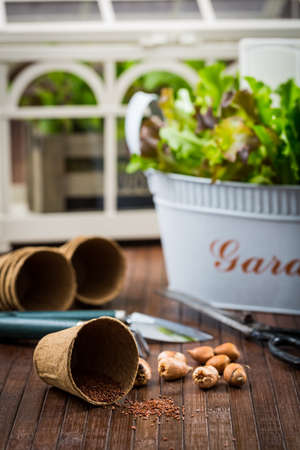Introduction to Kitchen Waste in Indian Homes
Exploring the vibrant diversity of kitchen waste generated in Indian households opens a fascinating window into the country’s regional cuisines and traditional cooking practices. From the bustling kitchens of Mumbai to the serene homes in Kerala, every meal preparation leaves behind an array of organic remnants—each telling its own culinary story. The very nature of Indian cooking, with its reliance on fresh vegetables, aromatic spices, and elaborate preparations, results in a colorful collection of peels, stems, seeds, leftover grains, and more. These kitchen discards are not just by-products; they reflect the heart of India’s food culture and form the foundation for eco-friendly composting traditions that have thrived for generations. As we journey through the types of kitchen waste found across different states and communities, we discover how these materials play an essential role in nurturing home gardens and contributing to sustainable living.
2. Types of Organic Kitchen Waste: Peels, Scraps & Leftovers
In every Indian kitchen, organic waste forms the soul of composting. From morning chai to the grand thali, our culinary journey produces a vibrant mix of peels, scraps, and leftovers. These wastes, when segregated mindfully, become the heartbeat of home composting—turning everyday discards into rich nourishment for our gardens.
Common Organic Wastes in Indian Homes
Let’s explore the quintessential organic wastes found in Indian households and their immense value in composting:
| Type of Waste | Typical Indian Examples | Composting Potential |
|---|---|---|
| Vegetable Peels | Potato, bottle gourd (lauki), carrot, ridge gourd (turai), pumpkin, onion skins | Adds moisture and nutrients; decomposes quickly |
| Fruit Skins & Cores | Mango peels, banana skins, orange rinds, apple cores, papaya seeds | High in sugars; speeds up microbial activity |
| Leftover Cooked Food (Non-oily) | Rice, dal remnants, chapati bits, steamed veggies | Nitrogen-rich; best added in moderation to avoid pests |
| Coffee & Tea Residue | Tea leaves (chai patti), coffee grounds | Improves soil texture; adds valuable minerals |
| Pulses & Grain Wash Water Residue | Mung dal skins, rice wash sediment (mandi) | Adds trace elements; enhances microbial diversity |
| Flower Offerings & Herbs | Marigold petals from puja, curry leaves, coriander stems | Adds color and aroma to compost; breaks down easily |
The Indian Connection: Unique Compost Ingredients
The flavors of India extend to our compost piles too! Think of betel nut shells after a paan treat or coconut husks from festive preparations—these are treasures for your garden. Even seasonal items like jackfruit rinds or mango stones play a role. By embracing these organic residues, we create a living cycle where the kitchen nurtures the earth and the earth gives back.
![]()
3. Non-organic Kitchen Waste: Packaging, Plastics & Foils
While the heart of every Indian kitchen beats with fresh vegetables and fragrant spices, there is also an ever-present stream of non-organic waste that flows quietly into our dustbins. This category includes plastic wrappers from masalas and snacks, colourful packaging from ready-to-eat foods, cling film, and the ever-handy aluminium foils that line our tiffin boxes. Unlike organic scraps, these materials do not break down naturally and play no role in home composting. In fact, their presence can hinder the decomposition process if mixed with organic matter.
In many Indian homes, segregation of kitchen waste is still evolving. It’s common to see plastics from oil packets or biscuit wrappers bundled together with wet waste. However, proper segregation is essential for both environmental health and effective composting. Non-compostable kitchen waste such as PET bottles, laminated pouches, and silver foils should be separated at source—ideally right where you chop your bhindi or peel your mangoes.
Adopting simple practices like using separate bins—one for wet waste destined for composting, another for dry recyclables, and a third for hazardous materials—can transform the way we manage our household discards. Educating family members, especially children, about why plastic wrappers or foils cannot go into the same bin as vegetable peels is a small but vital step towards building a greener tomorrow. In some urban areas, resident welfare associations (RWAs) are introducing colour-coded bins and community awareness drives to encourage this culture of conscious segregation.
Remember, while the dazzling packaging may tempt us in the supermarket aisles, its journey does not end at home. By ensuring non-organic kitchen waste stays out of your compost pile and enters proper recycling channels, you help protect both your garden soil and Mother Earth herself—a gesture as nurturing as tending to a marigold patch in full bloom.
4. Wet vs. Dry Waste: Indian Waste Segregation Habits
In the vibrant tapestry of Indian homes, the art of waste segregation has long been woven into daily life. The traditional practice of separating wet and dry kitchen waste not only reflects cultural wisdom but also plays a pivotal role in the success of composting. Let us delve into how this age-old habit nurtures both household gardens and the environment.
Understanding Wet and Dry Kitchen Waste
Indian kitchens brim with a variety of organic leftovers—peels from mangoes, potato skins, tea leaves, and more. These items, known as wet waste, are rich in moisture and nutrients, ideal for composting. On the other hand, dry waste encompasses materials like plastic wrappers, paper, foil, and packaging—items that do not decompose easily and require separate disposal.
Comparative Table: Wet vs. Dry Kitchen Waste
| Type | Examples | Decomposition Rate | Role in Composting |
|---|---|---|---|
| Wet Waste | Fruit & vegetable peels, food scraps, used tea leaves, eggshells | Fast (within weeks) | Essential for nutrient-rich compost; provides moisture & organic matter |
| Dry Waste | Plastic covers, cardboard, metal foils, glass bottles | Very slow (months to years or never) | Not suitable for composting; must be recycled or disposed separately |
The Indian Way: Everyday Segregation Rituals
Many Indian households use two bins—one for wet waste and another for dry waste. Mothers and grandmothers often pass down this knowledge through practical routines: collecting banana peels for garden manure or saving onion skins for vermicomposting pits. Such mindful separation ensures that compost heaps remain uncontaminated by plastics or chemicals, fostering healthy soil for home-grown tulsi plants or marigold borders.
Cultural Impact on Compost Quality
The discipline of wet-dry segregation has a profound impact on compost quality. When only pure organic matter is added to compost pits, decomposition accelerates naturally without foul odours or pests. This method echoes the deep-rooted Indian respect for Mother Earth—transforming every bit of kitchen waste into black gold that nourishes backyard gardens or rooftop pots. By honouring these segregation habits, urban and rural communities alike can cultivate greener spaces while reducing landfill burdens.
5. The Role of Spices, Oils & Indian Food Residues in Composting
Indian kitchens are fragrant sanctuaries of spices, oils, and diverse food residues. These elements give our meals their unique soul, but when it comes to composting, they need a mindful approach to ensure your compost heap flourishes like a lush monsoon garden.
Spices: Aroma & Impact on Compost
Spices such as turmeric, red chilli powder, garam masala, and coriander seeds often find their way into kitchen waste. While small quantities are generally harmless, large amounts can slow down the decomposition process due to their strong antimicrobial properties. To maintain balance:
- Add spice-laden scraps in moderation.
- Avoid dumping large piles of highly spiced food at once.
- Mix spicy residues well with neutral green and brown materials like vegetable peels or dry leaves.
Used Cooking Oils: Friend or Foe?
Oil is integral to Indian cooking—from tempering tadka to deep-frying samosas. However, used oils are best kept out of home compost bins. They create an oily film that suffocates beneficial microbes and attracts pests like rodents. If you must compost oily residues:
- Limit oil content to tiny traces left on food scraps; never pour liquid oil directly into compost.
- Combine oily leftovers with absorbent browns such as shredded newspaper or dry coconut husk.
Indian Food Residues: Sambar, Sabzi & More
Curry gravies, cooked rice, dal leftovers, and rotis are common in Indian households. While these can enrich compost with nutrients, they also break down quickly and may attract insects or animals if not managed properly:
- Bury cooked residues deep within the pile to mask aroma from scavengers.
- Avoid adding large amounts of dairy-based dishes (like paneer sabzi or kheer) as these decompose slowly and can cause odour issues.
- Balance wet food waste with dry carbon-rich material for optimal aeration.
The Secret: Balance & Layering
Just as we layer flavours in our curries, layering kitchen waste ensures healthy compost. Alternate nitrogen-rich food scraps with carbon-rich elements like dried leaves or cardboard. This practice maintains airflow and speeds up breakdown.
Garden Wisdom: Embrace Diversity
The magic of Indian cuisine lies in its diversity—and so does successful composting. By respecting the power of spices, limiting oils, and managing food residues thoughtfully, you transform kitchen waste into a blooming resource for your home garden’s vitality.
6. Cultural Practices & Composting: Temple Offerings and Traditional Ceremonies
The Sacred Cycle: From Rituals to Soil
Indian homes are deeply intertwined with a tapestry of cultural rituals, many of which generate unique types of kitchen waste. The act of preparing temple offerings—known as prasadam—and the grand feasts following festivals like Diwali, Pongal, or Onam, bring forth an abundance of organic materials. Banana leaves, coconut husks, flower garlands, and rice residues are just a few examples that weave their way from the sacred to the everyday kitchen bin.
Prasadam and Temple Waste
When families return from temples with prasadam—be it sweet pongal, ladoos, or fruits—their wrappers and leftovers often enter the household waste stream. In many South Indian homes, banana leaves used for serving prasadam are rinsed and set aside for composting. This practice not only honours tradition but also enriches compost with diverse nutrients.
Festival Leftovers: A Blessing for Compost
During festivals, kitchens brim with activity as special dishes are prepared in abundance. After the celebrations, surplus food scraps such as fruit peels, wilted flowers from pooja thalis, and remnants of traditional sweets provide an excellent source of nitrogen-rich material for compost bins. Such festive waste is typically free from chemicals and highly suitable for organic composting.
Traditional Wisdom: Reducing & Reusing
In many Indian households, elders impart age-old wisdom on minimizing waste during ceremonies. Items like coconut shells may be repurposed for handicrafts before finally being composted. Similarly, flower petals are often dried for natural dyes or potpourri prior to enriching garden soil.
Cultural Harmony with Nature
The seamless integration of cultural practices with composting reflects India’s long-standing reverence for nature. By consciously directing temple offerings and ceremonial leftovers into compost piles, families foster a sustainable cycle that transforms spiritual abundance into ecological nourishment—a true garden symphony rooted in tradition and blossoming in every home garden.
7. Conclusion: Embracing a Greener Kitchen the Indian Way
As we stand at the crossroads of tradition and innovation, Indian kitchens hold the power to nurture Mother Earth by embracing mindful waste segregation and composting. Our homes are filled with vibrant peels, fragrant herbs, and grains steeped in heritage—each a potential offering back to the soil. By recognising the types of kitchen waste unique to Indian households and understanding their role in composting, we can blend modern eco-friendly methods with age-old Indian wisdom. From using banana leaves as natural wrappers to transforming chai patti into rich compost, every small act becomes a tribute to sustainable living.
Let us encourage every family member—from grandparents to children—to honour the rhythms of nature by separating wet and dry waste, repurposing leftovers, and returning organic matter to the earth. When we choose to compost onion skins, vegetable scraps, or even temple flowers, we not only reduce landfill burden but also create nourishing black gold for our gardens and community spaces. The Indian way is rooted in respect for all life forms; let this spirit guide our daily actions in the kitchen.
Embracing a greener kitchen is not just about adopting a trend but reviving an ancient relationship with the land. As you stir your next pot of dal or prepare festive sweets, remember: every peel, pod, and shell has a sacred place in the circle of life. Let us walk this path together—combining modern science with timeless practices—and make our kitchens bloom with sustainability, harmony, and hope for future generations.


